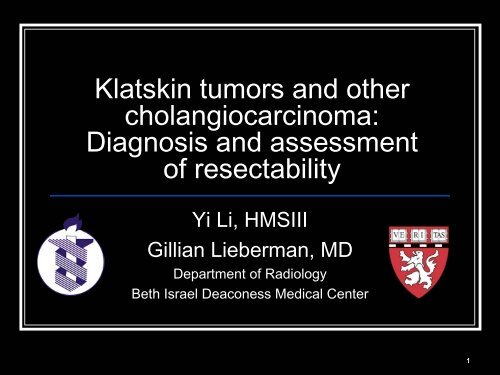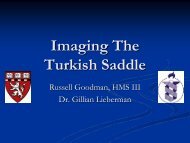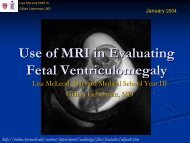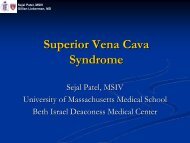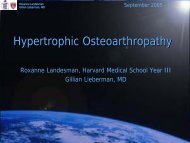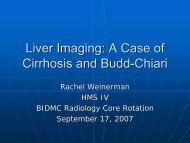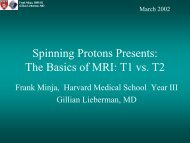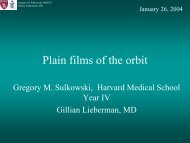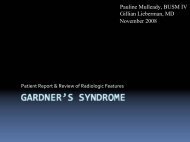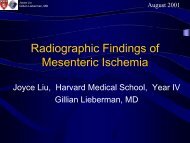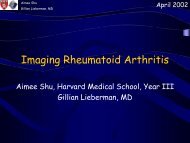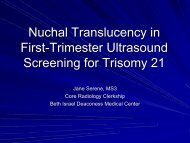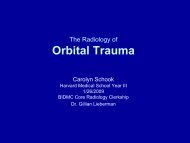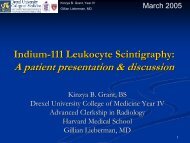Klatskin tumors and other cholangiocarcinoma - Lieberman's ...
Klatskin tumors and other cholangiocarcinoma - Lieberman's ...
Klatskin tumors and other cholangiocarcinoma - Lieberman's ...
Create successful ePaper yourself
Turn your PDF publications into a flip-book with our unique Google optimized e-Paper software.
<strong>Klatskin</strong> <strong>tumors</strong> <strong>and</strong> <strong>other</strong><br />
<strong>cholangiocarcinoma</strong>:<br />
Diagnosis <strong>and</strong> assessment<br />
of resectability<br />
Yi Li, HMSIII<br />
Gillian Lieberman, MD<br />
Department of Radiology<br />
Beth Israel Deaconess Medical Center<br />
1
Agenda<br />
Index patient<br />
DDx of painless jaundice<br />
Review of biliary anatomy<br />
DDx of biliary obstruction<br />
Cholangiocarcinoma<br />
Epidemiology <strong>and</strong> risk factors<br />
Clinical manifestations<br />
Classification<br />
Resectability<br />
Companion patients<br />
2
Index Patient: KR<br />
53M presented to PCP with painless jaundice<br />
ROS: Nausea, diarrhea, 20lb weight loss over<br />
last two months, dark urine, mild pruritus<br />
PE: jaundice, sublingual <strong>and</strong> scleral icterus,<br />
epigastric tenderness to palpation, no HSM<br />
Labs: Tbili: 23.8 (direct 19.4), AP 494, ALT 50,<br />
AST 90<br />
3
Differential Diagnosis: Painless<br />
Jaundice<br />
Unconjugated<br />
hyperbilirubinemia<br />
Increased bilirubin<br />
production (i.e. hemolysis)<br />
Hyperbilirubinemia<br />
Impaired hepatic<br />
bilirubin uptake (i.e. Gilbert’s)<br />
Impaired bilirubin<br />
conjugation (i.e. Crigler-Najjar)<br />
Conjugated<br />
Hyperbilirubinemia<br />
Hepatocellular<br />
injury/ Intrahepatic<br />
cholestasis<br />
(i.e. viral hepatitis)<br />
Biliary<br />
Obstruction<br />
4
Patient KR: Conjugated<br />
Hyperbilirubinemia<br />
Jaundice is physical manifestation of hyperbilirubinemia<br />
greater than 2mg/dL.<br />
Conjugated bilirubin (direct bilirubin) has already been filtered<br />
from the bloodstream into hepatocytes <strong>and</strong> conjugated to<br />
glucuronic acid.<br />
Our patient had a conjugated hyperbilirubinemia (his direct<br />
bilirubin was markedly elevated <strong>and</strong> constituted a large portion<br />
of his total bilirubin).<br />
Conjugated hyperbilirubinemia is due to either hepatocellular<br />
injury (preventing excretion of bilirubin from hepatocytes into<br />
the biliary system), or biliary obstruction (obstructing flow of<br />
bile into the GI tract). Thus, conjugated bilirubin builds up <strong>and</strong><br />
backs into the bloodstream.<br />
5
Patient KR: Likely Biliary<br />
Obstruction<br />
Our patient also had a markedly elevated alkaline<br />
phosphatase (AP), but only a mildly elevated AST<br />
<strong>and</strong> ALT<br />
AP is made by the canilicular cells lining the biliary ducts<br />
AST <strong>and</strong> ALT are made by hepatocytes<br />
A markedly elevated AP, relative to AST <strong>and</strong> ALT,<br />
implies that the site of injury is in the biliary ducts<br />
Thus, we can infer that our patient likely has a<br />
biliary obstruction leading to jaundice<br />
6
Review of Biliary Anatomy<br />
Plate 260, Netter’s Atlas of Human Anatomy 4 th Ed.<br />
Beaumont Hospitals.<br />
https://www.beaumonthospitals.com/health-library/P07694<br />
7
Menu of Radiologic Tests for Work-<br />
up of Biliary Obstruction<br />
Ultrasound (US)<br />
Transabdominal (TA US)<br />
Endoscopic (EUS)<br />
Computed Tomography (CT)<br />
Endoscopic Retrograde<br />
Cholangiopancreatography (ERCP)<br />
Magnetic Resonance Imaging (MRI)<br />
Magnetic Resonance Cholangiopancreatography<br />
(MRCP)<br />
8
Patient KR: Biliary Dilatation on<br />
RUQ US<br />
A P<br />
TA US, sagittal, patient KR<br />
Image Source: BIDMC (PACS)<br />
TA US:<br />
Bile ducts appear as<br />
tubular, branching<br />
lucencies<br />
Moderate intrahepatic<br />
ductal dilation<br />
No evidence of<br />
choledocholithiasis<br />
Not sensitive in the<br />
diagnosis of distal CBD<br />
stones due to gas in<br />
duodenum<br />
Dilated bile ducts signify<br />
distal biliary obstruction<br />
9
DDx of Biliary Obstruction<br />
Choledocholithiasis<br />
Tumors (i.e. <strong>cholangiocarcinoma</strong>)<br />
Primary sclerosing cholangitis<br />
AIDS cholangiopathy<br />
Acute <strong>and</strong> chronic pancreatitis<br />
Benign strictures (after invasive procedures)<br />
Parasitic infections (Ascaris lumbricoides, liver<br />
flukes)<br />
10
Patient KR: Hilar Stricture on<br />
ERCP<br />
ERCP, patient KR<br />
Image Source: BIDMC (PACS)<br />
Irregular appearance of<br />
intrahepatic bile ducts consistent<br />
with non-specific cholangitis<br />
Marked dilation of intrahepatic<br />
biliary ducts (L>R)<br />
Hilar stricture with narrowing of<br />
common, right <strong>and</strong> left hepatic<br />
ducts<br />
Pattern of stricture is highly<br />
suspicious for <strong>cholangiocarcinoma</strong><br />
A stent was placed in the CBD to<br />
facilitate biliary drainage, <strong>and</strong> bile<br />
duct brushings were obtained <strong>and</strong><br />
sent to pathology<br />
11
Patient KR: Soft Tissue <strong>and</strong><br />
Lymph Node Necrosis on C+ CT<br />
C+ CT, axial, arterial phase, patient KR<br />
Image Source: BIDMC (PACS)<br />
Triple phase imaging is<br />
important because<br />
<strong>cholangiocarcinoma</strong> has<br />
slow wash out in delayed<br />
phase due to dense, fibrous<br />
stroma<br />
Ill-defined, low attenuation,<br />
soft-tissue around the porta<br />
hepatis, consistent with<br />
tumor growth<br />
Low attenuation mass<br />
between IVC <strong>and</strong> portal<br />
vein, consistent with necrotic<br />
lymph node<br />
12
Patient KR: Bile Duct Dilatation<br />
<strong>and</strong> Liver Metastasis on C+ CT<br />
C+ CT, axial, delayed phase, patient KR<br />
Image Source: BIDMC (PACS)<br />
Moderate intrahepatic bile duct<br />
dilatation<br />
Metastasis to liver<br />
13
Patient KR: Tumor Invasion into<br />
Cystic Duct on C+ CT<br />
C+ CT, axial, delayed phase, patient KR<br />
Image Source: BIDMC (PACS)<br />
Soft tissue in distal cystic duct<br />
Cystic duct should appear low<br />
attenuation when filled with<br />
bile, similar to adjacent<br />
gallbladder<br />
In this picture, cystic duct<br />
appears distended <strong>and</strong> high in<br />
attenuation<br />
Stent in CBD<br />
Biopsy-proven diagnosis (from<br />
ERCP): adenocarcinoma,<br />
likely of biliary origin<br />
<strong>Klatskin</strong> <strong>cholangiocarcinoma</strong><br />
14
Cholangiocarcinoma:<br />
Pathogenesis <strong>and</strong> Epidemiology<br />
Bile duct cancer arising in the intrahepatic, perihilar, or<br />
distal biliary tree, exclusive of gallbladder <strong>and</strong> ampulla of<br />
Vater<br />
Originate from epithelial cells of biliary duct<br />
90% adenocarcinoma, 10% squamous cell carcinoma<br />
Highly lethal: often locally advanced at presentation<br />
5-year-survival rate: 5-10%<br />
In US, 1-2 cases per 100,000 population, but incidence<br />
is rising (possible detection bias)<br />
15
Risk Factors<br />
Primary sclerosing cholangitis<br />
Lifetime risk: 10-15%<br />
Average age at time of diagnosis: 30s-50s<br />
Fibropolycystic liver disease<br />
i.e. Caroli’s syndrome, congenital hepatic fibrosis, choledochal cysts<br />
Lifetime risk: 15%<br />
Average age at time of diagnosis: 30s-50s<br />
Parasitic Infection<br />
Liver flukes of Clonorchis <strong>and</strong> Opisthorchis genera (from undercooked fish)<br />
Cholelithiasis <strong>and</strong> haptolithiasis<br />
Toxic exposure<br />
Thorotrast<br />
Lynch syndrome <strong>and</strong> biliary papillomatosis<br />
Chronic liver disease<br />
Viral hepatitis<br />
16
Common Clinical Manifestations<br />
Symptoms:<br />
Pruritus (66%)<br />
RUQ pain (30-50%)<br />
Weight loss (30-50%)<br />
Fever (20%)<br />
Acholic stools; dark<br />
urine<br />
Cholangitis (rare)<br />
Physical Signs:<br />
Jaundice (90%)<br />
Hepatomegaly (25-40%)<br />
RUQ mass (10%)<br />
Courvoisier’s sign (rare)<br />
17
Tumor Classification<br />
Intrahepatic (Peripheral): small intrahepatic ductules (5-10%)<br />
Hilar: extrahepatic ductules (including confluence) up to point where<br />
common bile duct lies posterior to duodenum (60-70%)<br />
<strong>Klatskin</strong>: involving confluence of left <strong>and</strong> right hepatic ducts<br />
Extrahepatic (Distal): originate in extrahepatic biliary duct after CBD<br />
travels posterior to duodenum (20-30%)<br />
Patel T (2006) Cholangiocarcinoma<br />
Nat Clin Pract Gastroenterol Hepatol 3: 33–42 doi:10.1038/ncpgasthep0389<br />
18
Bismuth-Corlette Classification<br />
Hilar <strong>cholangiocarcinoma</strong>s are<br />
further sub-classified based on the<br />
specific ducts involved<br />
Type I<br />
Type II<br />
Type IIIa<br />
Type IIIb<br />
Type IV<br />
Type IV is important because it<br />
involves both left <strong>and</strong> right hepatic<br />
ducts <strong>and</strong> therefore is<br />
unresectable.<br />
Patel T (2006) Cholangiocarcinoma<br />
Nat Clin Pract Gastroenterol Hepatol 3: 33–42 doi:10.1038/ncpgasthep0389 19
TNM Tumor Staging<br />
Stage Grouping:<br />
Stage I: T1 N0 M0<br />
Stage II: T2 N0 M0<br />
Stage IIIA: T3 N0 M0<br />
Stage IIIB: T4 N0 M0<br />
Stage IIIC: any T N1 M0<br />
Stage IV: any T any N M1<br />
T0 No evidence of primary tumor<br />
T1 Solitary tumor w/o vascular invasion<br />
T2 Solitary tumor with vascular invasion, or multiple <strong>tumors</strong><br />
5cm or tumor involving major branch<br />
of portal or hepatic veins<br />
T4 Tumors with direct invasion of adjacent organs <strong>other</strong><br />
than the gallbladder or with perforation of the visceral<br />
peritoneum<br />
N0 No regional lymph node metastasis<br />
N1 Regional lymph node metastasis<br />
M0 No distant metastasis<br />
M1 Distant metastasis<br />
20
Surgical resection is the only curative<br />
method for <strong>cholangiocarcinoma</strong><br />
Unfortunately, at the time of presentation,<br />
most patients have locally advanced<br />
disease that is not surgically resectable<br />
Criteria for surgical resectability are based<br />
on anatomical structures involved in tumor<br />
growth<br />
21
Radiologic Assessment of Surgical<br />
Resectability: Criteria for Resectability<br />
Radiologic assessment begins with a pre-operative CT<br />
Limited sensitivity; can establish resectability in only 60% of<br />
cases<br />
Tumors are NOT resectable if:<br />
Retropancreatic <strong>and</strong> paraceliac nodal metastases<br />
Liver metastases<br />
Invasion of portal vein, main hepatic artery, or proximal<br />
branches<br />
Extrahepatic organ invasion<br />
Disseminated disease<br />
22
Criteria for Resectability of Hilar<br />
Tumors<br />
Hilar <strong>tumors</strong> are NOT resectable if:<br />
Bilateral hepatic duct involvement up to second radicles<br />
bilaterally (Bismuth IV)<br />
Encasement/occlusion of main portal vein proximal to its<br />
bifurcation<br />
Atrophy of one liver lobe with encasement of contralateral portal<br />
vein branch<br />
Atrophy of one liver lobe with contralateral secondary biliary<br />
radicle involvement<br />
Involvement of bilateral hepatic arteries<br />
23<br />
23
Surgical Exploration: Ultimate<br />
Determination of Resectability<br />
Resectability is ultimately determined at time of surgery<br />
If pre-operative CT demonstrates unresectable disease, patient may<br />
receive palliative medical management or palliative surgery (biliaryenteric<br />
bypass to alleviate obstruction)<br />
In all <strong>other</strong> cases, patient will undergo surgical exploration to determine<br />
resectability<br />
If the tumor is resectable, it will be resected<br />
If tumor is deemed unresectable after exploration, surgeon may perform a<br />
palliative bypass to alleviate obstruction<br />
Intra-operative US may be used intra-operatively assess<br />
depth of tumor invasion <strong>and</strong> aid in surgical decisionmaking<br />
24
Example of Unresectable Tumor:<br />
Celiac Invasion<br />
C+ CT, axial, delayed phase, patient MB<br />
Image Source: BIDMC (PACS)<br />
Companion Patient 1:<br />
MB<br />
Invasion of celiac<br />
artery<br />
Infiltrative soft tissue mass<br />
extending along the celiac<br />
axis<br />
25
Example of Unresectable Tumor:<br />
Liver Metastasis<br />
C+ CT, axial, delayed phase, patient KR<br />
Image Source: BIDMC (PACS)<br />
Index patient: KR<br />
Liver Metastasis<br />
26
Discussion of Companion Patients<br />
27
Companion Patient 2: Central<br />
Necrosis on C+ CT<br />
C+ CT, axial, arterial phase, patient DM<br />
Image Source: BIDMC (PACS)<br />
79F with 6 week history<br />
of mid-epigastric pain<br />
<strong>and</strong> jaundice<br />
C+ CT Abdomen<br />
6.6 x 6.2cm mass with<br />
peripheral enhancement in<br />
arterial phase<br />
Central necrosis<br />
28
Patient 2: Hyper-enhancement on<br />
Delayed Images<br />
Arterial Venous Delayed<br />
Area of peripheral enhancement in arterial phase, with progressive central<br />
hyper-enhancement in venous phase <strong>and</strong> marked, progressive central<br />
enhancement in delayed phase (10-minute-delay).<br />
C+ CT, axial, triple phase, patient DM<br />
Image Source: BIDMC (PACS)<br />
29
Patient 2: Fibrotic Tumor on C+ CT<br />
Mass with an irregular<br />
margin, suggestive of<br />
a fibrotic tumor<br />
C+ CT, axial, delayed phase, patient DM<br />
Image Source: BIDMC (PACS) 30
Patient 2: Gallbladder Wall<br />
Invasion on C+ CT<br />
C+ CT, axial, arterial phase, patient DM<br />
Image Source: BIDMC (PACS)<br />
Hyperenhancing nodule<br />
by gallbladder signifying<br />
invasion of gallbladder<br />
wall<br />
Biopsy-proven diagnosis:<br />
adenocarcinoma<br />
Intrahepatic<br />
Cholagiocarcinoma<br />
31
Companion Patient 3: Biliary Dilatation<br />
<strong>and</strong> CHD Stricture on HASTE MRI<br />
MRI, coronal, HASTE, patient HK<br />
Image Source: BIDMC (PACS)<br />
67M with 3 week history of<br />
jaundice, pruritus <strong>and</strong> weight<br />
loss<br />
OSH scans: dilated bile ducts<br />
<strong>and</strong> CBD strictures consistent<br />
with <strong>cholangiocarcinoma</strong><br />
MRA to assess resectability:<br />
Marked bilateral, intrahepatic<br />
ductal dilation to porta hepatis<br />
3 cm common hepatic duct<br />
stricture<br />
32
Patient 3: Liver Metastasis on<br />
HASTE MRI<br />
Low signal area<br />
near gallbladder<br />
fundus<br />
Signifies metastasis<br />
Tumor is<br />
unresectable<br />
MRI, coronal, HASTE, patient HK<br />
Image Source: BIDMC (PACS) 33
Patient 3: Dilated Bile Ducts <strong>and</strong><br />
CHD Stricture on MRCP<br />
MRCP, patient HK<br />
Image Source: BIDMC (PACS)<br />
Dilated intrahepatic bile<br />
ducts<br />
Long CHD stricture<br />
extending to CBD<br />
Incidental finding:<br />
Pancreatic cysts (IPMT)<br />
Biopsy-proven diagnosis:<br />
adenocarcinoma<br />
<strong>Klatskin</strong><br />
<strong>cholangiocarcinoma</strong><br />
34
Summary (1)<br />
Cholangiocarcinoma can be a challenging<br />
radiographic diagnosis, <strong>and</strong> an even more<br />
challenging cancer to treat.<br />
3 classificaitons of <strong>cholangiocarcinoma</strong>:<br />
Intrahepatic<br />
Hilar (including <strong>Klatskin</strong>)<br />
Extrahepatic<br />
Hilar <strong>cholangiocarcinoma</strong>s are further subclassified<br />
based on specific ductal involvement,<br />
by the Bismuth-Corlette classification system<br />
35
Summary (2)<br />
Many radiographic modalities are<br />
important in the diagnosis of<br />
<strong>cholangiocarcinoma</strong><br />
US, CT, ERCP, MRCP, MRI<br />
Radiology is helpful in determining<br />
surgical resectability, <strong>and</strong> can influence<br />
surgical management<br />
36
References<br />
Anderson C <strong>and</strong> stuart KE. Treatment of <strong>cholangiocarcinoma</strong>. UpToDate; retreived February<br />
2009. http://utdol.com<br />
Blechacz B et al. Cholangiocarcinoma: Advances in pathogenesis, Diagnosis, <strong>and</strong> Treatment.<br />
Hepatology 2008; 48: 308-321.<br />
Chowdhury NR <strong>and</strong> Chowdhury JR. Diagnostic approach to the patient with jaundice or<br />
asymptomatic hyperbilirubinemia. UpToDate; retreived February 2009. http://utdol.com<br />
Khan SA et al. Cholangiocarcinoma. Lancet 2005; 366: 1303-1314.<br />
Lowe RC et al. Epidemiology; pathogenesis; classification of <strong>cholangiocarcinoma</strong>. UpToDate;<br />
retreived February 2009. http://utdol.com<br />
Lowe RC et al. Clinical manifestations <strong>and</strong> diagnosis of <strong>cholangiocarcinoma</strong>. UpToDate;<br />
retreived February 2009. http://utdol.com<br />
Novelline RA. Squire’s Fundamentals of Radiology. 6 th ed. Harvard University Press, 2004.<br />
Weber A et al. Diagnostic approaches for <strong>cholangiocarcinoma</strong>. World J Gastroenterol 2008:<br />
14(26) 4131-4136.<br />
37
Acknowledgements<br />
A special thank you to: Aarti Sekhar, MD<br />
Gillian Lieberman, MD<br />
Ivan Pedrosa, MD<br />
Iva Petkovska, MD<br />
Charles Vollmer, MD<br />
Maria Levantakis<br />
Larry Barbaras<br />
38


